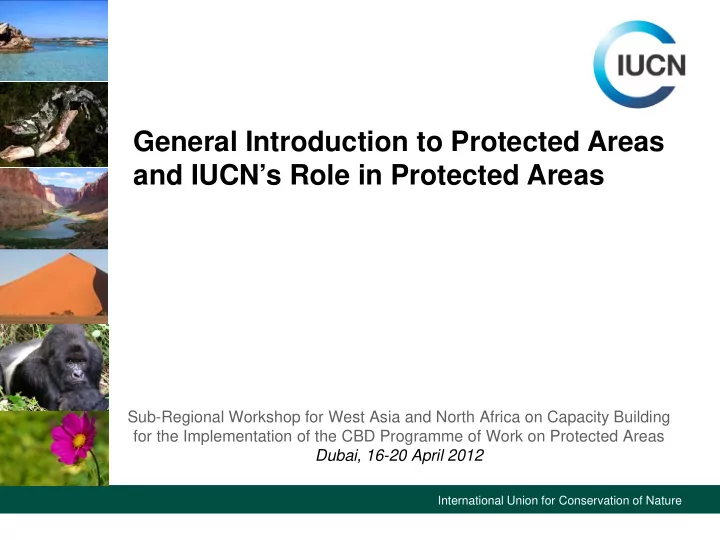

General Introduction to Protected Areas and IUCN’s Role in Protected Areas Sub-Regional Workshop for West Asia and North Africa on Capacity Building for the Implementation of the CBD Programme of Work on Protected Areas Dubai, 16-20 April 2012 International Union for Conservation of Nature
This presentation will cover: What are Protected Areas; What is IUCN’s role; Key future challenges. International Union for Conservation of Nature
What is a Protected Area ? « A clearly defined geographic space, recognized, dedicated and managed, through legal or other effective means, to achieve the lon g term conservation of nature with associated ecosystem services and cultural values » IUCN 2008 International Union for Conservation of Nature
Protected Areas now cover more than 12% of the earths surface. The numbers of such areas have increased rapidly in recent years and protected areas are now a major land use in their own right International Union for Conservation of Nature
Figure 1: Cumulative Growth in Protected Areas by 5 Year Increment: 1872-2003 Area of sites Number of sites Number of sites 2 ) Area (km 18,000,000 100,000 16,000,000 14,000,000 80,000 12,000,000 60,000 10,000,000 8,000,000 40,000 6,000,000 4,000,000 20,000 2,000,000 0 0 International Union for Conservation of Nature 1872 1887 1902 1917 1932 1947 1962 1977 1992 2003
The Wor The orlds ds P Prot otec ected A ed Areas eas 1980: 80: 40,000 p 000 protec ected a ed areas as c covering 7 ng 7,000, 00,00 000 k 0 km 2 2007: 07: 106, 6,000 000 protec ected a ed areas as c cover ering ng 1 18,000, 000,000 000 km 2 UNEP World Conservation Monitoring Centre UNEP World Conservation Monitoring Centre
Figure 2: Protected Areas as Proportion of Global Land Use 30 26.1% 23.4% 25 % Global Land Area (148,453,304 km 2 ) 20 11.5% 15 9.2% 10 0.9% 0.2% 5 0 Forest (1) Permanent Protected Areas Arable Land (4) Permanent Crop Urban UNEP World Conservation Monitoring Centre Pasture (2) (3) (5)
Well managed Protected Areas are essential for addressing biodiversity loss and for protecting species – particularly those threatened by habitat loss International Union for Conservation of Nature
Jean-Christophe Vié International Union for Conservation of Nature IUCN Species Programme, Gland, Switzerland
IUCN’s role in protected areas: recognized as a global leader in relation to protected areas, particularly in relation to standard setting, provision of policy advice and convening key forums and dialogues International Union for Conservation of Nature
Our mission: to promote an effectively managed, representative system of marine and terrestrial protected areas International Union for Conservation of Nature
How do we work ? The IUCN Programme on Protected • Areas (PPA) is a Secretariat Programme based in IUCN HQ and increasingly in most IUCN Regions International Union for Conservation of Nature
How do we work ? • The IUCN World Commission on Protected Areas (WCPA) is the world’s leading network of protected areas specialists and has 1,400 members in 150 countries • PPA and WCPA work together as « One Programme » to deliver IUCN’s work in relation to protected areas International Union for Conservation of Nature
Key IUCN strengths and activities in protected areas include: 1) Knowledge – preparation of practical guidance on a range of management issues, such as through the Protected areas Best Practice Series International Union for Conservation of Nature
International Union for Conservation of Nature
Key IUCN strengths and activities in protected areas include: 2) Convening – major events such as the World Parks Congress, convened by IUCN every 10 years International Union for Conservation of Nature
International Union for Conservation of Nature
Key IUCN strengths and activities in protected areas include: 3) Standard Setting – such as in relation to the IUCN PA Category System International Union for Conservation of Nature
Key IUCN strengths and activities in protected areas include: 4) Advising Conventions and Agreements: such as the World Heritage Convention and the Convention on Biological Diversity International Union for Conservation of Nature
IUCN’s Role in World Heritage IUCN is the Advisory Body for natural Sites for the WH Convention. This involves: (a) evaluation of new sites; (b) preparation of State of Conservation Reports; and (c) support to training and capacity building activities.
Key IUCN strengths and activities in protected areas include: 5) Support for protected areas field projects, such as training PA managers in many countries International Union for Conservation of Nature
PAs Management Planning Training Workshop/UAE (Nov.2009)
FUTURE DIRECTIONS INCLUDE: (1) Addressing impacts of climate change. Particularly through developing landscape level initiatives which link protected areas with other land uses. International Union for Conservation of Nature
Protected areas in the 21st Century 2° to 6 ° warming
FUTURE DIRECTIONS INCLUDE: (2) Targeted expansion of PAs in poorly represented biomes. Increasing the protection of the marine environment is a major priority International Union for Conservation of Nature
PA Coverage in the marine environment is less than 7%
FUTURE DIRECTIONS INCLUDE (3) Strengthening management effectiveness (capacity building and PA finance). The IUCN Management effectiveness framework is a tool being used in many countries International Union for Conservation of Nature
FUTURE DIRECTIONS INCLUDE (4) Involving local communities and Indigenous Peoples in protected areas. Community Conserved Areas – Pas managed by local communities have become increasingly important International Union for Conservation of Nature
THANK YOU Khaldoun Alomari Protected Areas Program Officer/Species Focal Point Regional Office for West Asia (ROWA) IUCN (International Union for Conservation of Nature) Um Uthaina, Tohama Str. No. 6 Tel: 00962 6 5546912/3/4, Fax: 00962 6 5546915 Mobile: 00962777888344, www.iucn.org/westasia International Union for Conservation of Nature
Recommend
More recommend